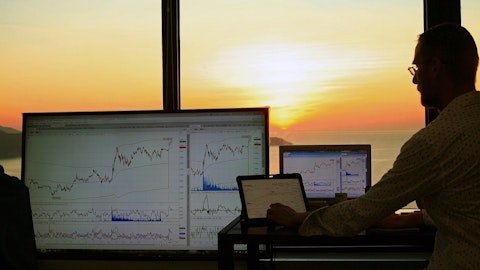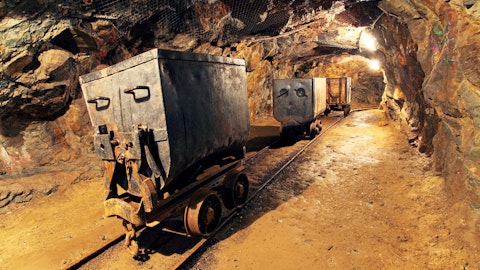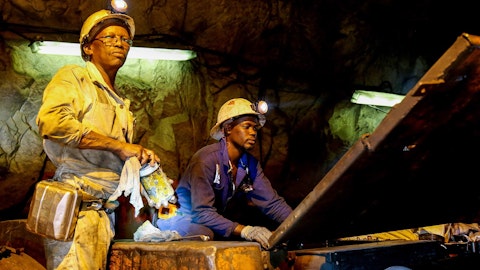Richard Adkerson: No, I was just going to say, Chris, and Kathleen can talk about the details. When we announced the financial policy, as I looked out and I said, the likelihood is, cash is going to come in faster than we can spend it just because of the nature of our capital projects are long term. It takes a lot of time. This has happened before Freeport. Two previous occasions in our history, we got down to zero net debt. This is setting aside the smelter because that’s financed on its own. But, what this does is by having that cushion between where our debt is and our debt target is, it will allow us to readily be able to finance future construction projects. But it’s just the way the cash flows in versus — we don’t feel any compulsion to spend money to get the debt up to that target.
Chris LaFemina: Okay. So, should we think of it more as a net debt target of below $4 billion rather than $3 billion to $4 billion?
Richard Adkerson: Well, I think…
Kathleen Quirk: $3 billion to $4 billion is the limit. Yes, $3 billion to $4 billion is what we — yes.
Chris LaFemina: Got it. Okay. Good. And then sorry, second question on Grasberg. You — it looks like you’ve increased your gold production guidance for 2024, €˜25 and €˜26, but copper volumes are pretty much the same. So, is there something — what’s happening there to result in an increase and what you expect to get out of that mine in terms of gold over those three years?
Richard Adkerson: Well, while the numbers look simple, the mine planning is complicated. And we report the results of our mine planning quarterly. And what you’re seeing there is some revisions in mine planning to optimize resource recovery. It wasn’t any target. It’s just the way that — the way that the mineralization of these ore bodies fall out as we change future mine plans. And…
Kathleen Quirk: Yes, there was some changes between Grasberg Block Cave and Deep MLZ. And additionally, we’ve been getting higher gold recoveries than we had previously forecast. And that’s helping us as well. So, those are the main differences.
Richard Adkerson: And it’s not a targeting it — it’s not a targeting exercise, Chris. I mean, we didn’t do something to try to get more gold. It was just — if we look at the orebody, we maximize the value. It’s a dynamic process and report to you the results of that process, and that’s what it is.
Operator: Your next question will come from the line of Lawson Winder with Bank of America Securities. Please go ahead.
Lawson Winder: Good morning, Richard. Good morning, Kathleen. Very nice to hear from you both, and thank you for your time and the update today. I wanted to hopefully ask you two questions. Just one on the C1 cash cost guidance for 2023. To what extent might some of these higher costs year-over-year continue into 2024? Like what is the percentage of those that are more structural as opposed to potentially more cyclical?
Kathleen Quirk: I think you can look at — I think you can look at the makeup of our costs. On that slide, we provide a makeup. And labor cost is something that’s kind of stays with you. Materials and supplies, a component of that is commodity driven and a component of its services driven. The energy, I think, is more variable and things like sulfuric acid is more variable. So, you can look at that pie chart and get a feel for which ones have the ability to change, and we provide some sensitivities on things like currencies and diesel costs.
Richard Adkerson: Okay. And one thing that’s — one thing that’s a real benefit of Freeport that we say a lot. I’m not sure if this is recognized as much as it ought to be. But, we operate every mine that we have an interest in. We have joint venture partners. But unlike other operations where those joint ventures are run as a standalone business, we operate globally through our operatorship rights. And that makes us really important customers of our suppliers. We’re generally one of the very largest customers of people who provide our major supplies. And so, as those suppliers globally have been working to pass along their input cost, our global supply team working with our operations have been affected in mitigating certain of those costs.
We’ve had some impact. But again, it’s a real dynamic situation and — you saw we came in below our quarter-ago estimate. Some costs are moderating, some are carrying over, but it’s just an ongoing thing. And we give you the best outlook we have, and then we work hard to try to operate with as low a cost as we can.
Lawson Winder: And then, I wanted to follow up on your comments around El Abra and the plans to advance water infrastructure. Are you considering desalination capacity? Is that what you’re referring to there? And then…
Kathleen Quirk: Yes.
Richard Adkerson: Yes. That’s really the only alternative.
Lawson Winder: Okay. And then what would the time line be on that?





